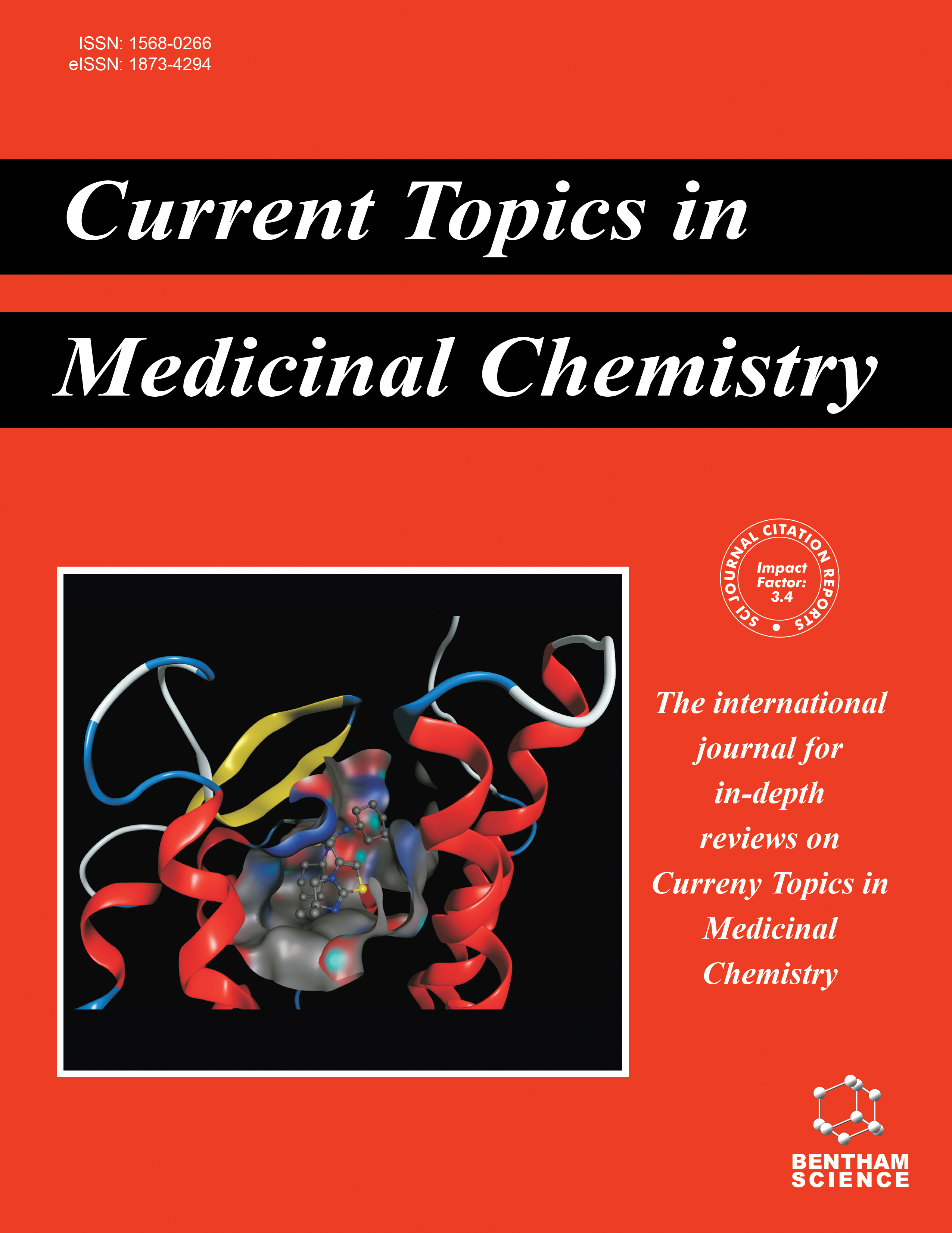- Home
- A-Z Publications
- Current Topics in Medicinal Chemistry
- Previous Issues
- Volume 12, Issue 6, 2012
Current Topics in Medicinal Chemistry - Volume 12, Issue 6, 2012
Volume 12, Issue 6, 2012
-
-
Editorial [Hot Topic :Current Advances In Therapeutic Applications of Nuclear Receptors (Guest Editor: Stefano Fiorucci)]
More LessThis issue of Current Topic of Medicinal Chemistry highlight several aspects of the medicinal chemistry of nuclear receptors and their relevance in drug discovery by collecting comprehensive reviews from outstanding investigators involved in the field and examines the biology of specific subfamilies of these ligand-activated regulatory factors that might have relevance in the therapy of a wide variety of human alignments. Read More
-
-
-
General Molecular Biology and Architecture of Nuclear Receptors
More LessAuthors: Michal Pawlak, Philippe Lefebvre and Bart StaelsNuclear receptors (NRs) regulate and coordinate multiple processes by integrating internal and external signals, thereby maintaining homeostasis in front of nutritional, behavioral and environmental challenges. NRs exhibit strong similarities in their structure and mode of action: by selective transcriptional activation or repression of cognate target genes, which can either be controlled through a direct, DNA binding-dependent Read More
-
-
-
Retinoid Receptors and Therapeutic Applications of RAR/RXR Modulators
More LessRetinoic acid receptors (RARs) are ligand-controlled transcription factors that function as heterodimers with retinoid X receptors (RXRs) to regulate cell growth, differentiation, survival and death. Due to their regulatory potential, these nuclear receptors (NRs) are major drug targets for a variety of pathologies, including cancer and metabolic diseases. A large amount of RAR- and RXR-selective ligands, ranging from (partial) agonis Read More
-
-
-
Current Status of Vitamin D Signaling and Its Therapeutic Applications
More LessAuthors: Carsten Carlberg and Ferdinand MolnarVitamin D and in particular its biologically most active metabolite, 1α,25-dihydroxyvitamin D3 (1α,25(OH)2D3), are central endocrine molecules that influence many aspects of human physiology, which are not only the well-known calcium and phosphorus up-take and transport controlling bone formation, but also the control of immune functions and of cellular growth and differentiation. Basically all actions of 1α,25(OH)2D3 are Read More
-
-
-
Biology and Therapeutic Applications of Peroxisome Proliferator- Activated Receptors
More LessAuthors: Maria P. Menendez-Gutierrez, Tamas Roszer and Mercedes RicotePeroxisome proliferator-activated receptors (PPARs) are ligand dependent transcription factors. The three mammalian PPARs are key regulators of fatty acid and lipoprotein metabolism, glucose homeostasis, cellular proliferation/ differentiation and the immune response. PPARs are therefore important targets in the treatment of metabolic disorders such as insulin resistance and type 2 diabetes mellitus, and are also of interes Read More
-
-
-
Update on Cardiovascular Safety of PPARgamma Agonists and Relevance to Medicinal Chemistry and Clinical Pharmacology
More LessAuthors: Andreea Ciudin, Cristina Hernandez and Rafael SimoPeroxisome proliferator-activator receptors (PPARs) are now known as members of the nuclear hormonereceptor superfamily of ligand-activated transcription factors that regulate gene expression in response to nutritional and physiological stimuli. PPARγ plays a crucial role in glucose homeostasis and it is involved in the regulation of lipid metabolism and adipocyte differentiation and function. From all the PAARγ ligands Read More
-
-
-
Development of FXR, PXR and CAR Agonists and Antagonists for Treatment of Liver Disorders
More LessAuthors: Stefano Fiorucci, Angela Zampella and Eleonora DistruttiThe farnesoid-x-receptor (FXR), the constitute-androstane-receptor (CAR) and the pregnane-x-receptor (PXR) are ligand regulated nuclear receptors highly expressed in the liver and intestine supervising essential steps in the metabolism of xeno and endo-biotics in entero-hepatic tissues. Primary and secondary bile acids function as receptor agonists/ activators for these receptors. Activation of FXR by steroidal an Read More
-
-
-
Molecular Determinants of Gastrointestinal and Liver Cancers: Role of Bile Acid Activated Nuclear Receptors
More LessAuthors: Barbara Renga, Andrea Mencarelli, Sabrina Cipriani and Eleonora DistruttiInvasion and metastasis are critical determinants of gastrointestinal and liver cancers morbidity. Genes and molecules participating in these steps (e.g. growth factors and their receptors, cell cycle regulators, cell adhesion molecules, matrix degrading enzymes) have been progressively clarified. Activated Wnt signaling pathway has been found in these tumors. Mutations in one of the DNA mismatch repair genes, alterati Read More
-
-
-
Natural Ligands for Nuclear Receptors: Biology and Potential Therapeutic Applications
More LessAuthors: Maria Valeria D'Auria, Valentina Sepe and Angela ZampellaNuclear receptors are key regulators of various processes including reproduction, development, and metabolism of xeno- and endobiotics. Research in the last two decades has focused to the development of novel drugs specifically targeting nuclear receptors for the treatment of a variety of diseases, such as cancer, diabetes, dyslipidemia, fatty liver disease, drug hepatotoxicity and cholestasis. The search for novel Read More
-
Volumes & issues
-
Volume 25 (2025)
-
Volume 24 (2024)
-
Volume 23 (2023)
-
Volume 22 (2022)
-
Volume 21 (2021)
-
Volume 20 (2020)
-
Volume 19 (2019)
-
Volume 18 (2018)
-
Volume 17 (2017)
-
Volume 16 (2016)
-
Volume 15 (2015)
-
Volume 14 (2014)
-
Volume 13 (2013)
-
Volume 12 (2012)
-
Volume 11 (2011)
-
Volume 10 (2010)
-
Volume 9 (2009)
-
Volume 8 (2008)
-
Volume 7 (2007)
-
Volume 6 (2006)
-
Volume 5 (2005)
-
Volume 4 (2004)
-
Volume 3 (2003)
-
Volume 2 (2002)
-
Volume 1 (2001)
Most Read This Month
Article
content/journals/ctmc
Journal
10
5
false
en


